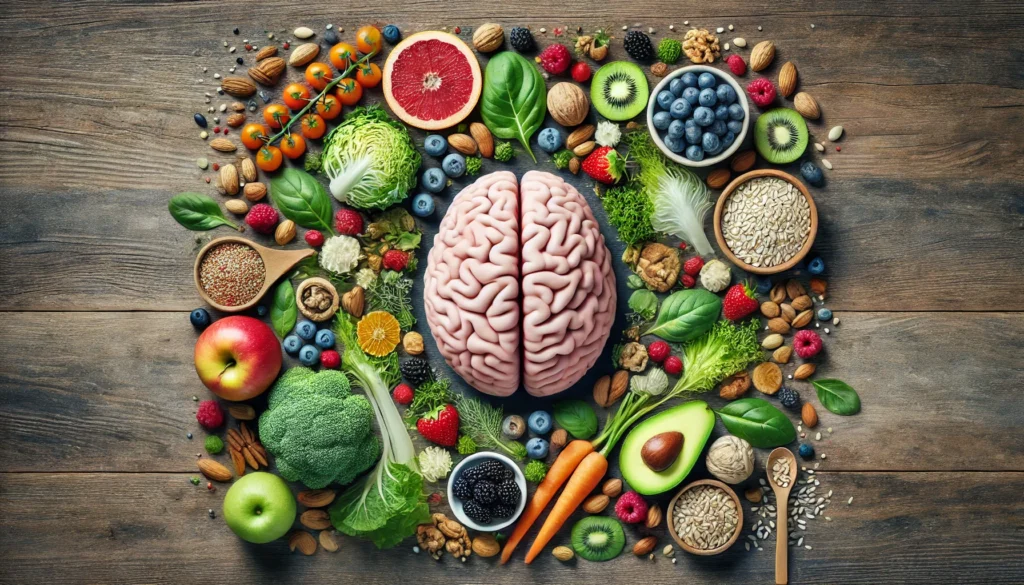In the ever-expanding landscape of nutritional science, few dietary approaches have captured both scientific and public attention as powerfully as the MIND diet. Developed to protect against cognitive decline and support brain vitality through aging, the MIND diet plan blends the proven principles of two of the world’s healthiest eating patterns—the Mediterranean and DASH diets—into a unified framework tailored for cognitive preservation. As the global population ages and the burden of neurodegenerative disorders like Alzheimer’s disease rises, the importance of dietary interventions for brain health becomes increasingly critical. Understanding how the MIND diet works, the mind diet food list, and how to practically implement a mind diet meal plan offers a promising strategy for those seeking to support long-term brain function and longevity through evidence-based nutrition.
You may also like: Best Brain Foods for Focus, Memory, and Longevity: What Science Says
The MIND Diet: Origins and Scientific Foundations
The MIND diet, an acronym for Mediterranean-DASH Intervention for Neurodegenerative Delay, was first proposed by researchers at Rush University Medical Center in 2015. Its foundation rests on decades of epidemiological and clinical research linking diet with cognitive outcomes. The primary architect of the mind diet details, nutritional epidemiologist Dr. Martha Clare Morris, designed the plan by identifying specific dietary components most consistently associated with reduced risk of Alzheimer’s disease. By emphasizing foods known to nourish neuronal health and limiting those linked to cognitive decline, the MIND diet emerged as a highly targeted approach to slowing brain aging.
Distinct from its Mediterranean and DASH predecessors, the MIND diet is not a generic heart-healthy regimen but a brain-optimized one. Its unique value lies in its deliberate prioritization of mind grains, berries, leafy greens, nuts, and olive oil, each selected for their neuroprotective properties. Scientific studies suggest that even moderate adherence to the MIND diet can yield significant cognitive benefits. For example, one landmark study published in Alzheimer’s & Dementia found that individuals who followed the MIND diet closely had a 53% reduced risk of developing Alzheimer’s disease, while even moderate followers saw a 35% reduction in risk. These findings underscore the diet’s robust potential in real-world settings, especially when used as part of a comprehensive mind diet menu plan.
Understanding the MIND Diet Food List and Nutritional Priorities
At the heart of the mind diet eating plan is a curated selection of food groups shown to protect the brain and support overall neurological integrity. The mind diet food list is composed of ten “brain-healthy” food categories and five categories to limit or avoid. The beneficial foods include leafy green vegetables, other vegetables, berries, nuts, whole grains (especially mind grains like oats, quinoa, and brown rice), fish, poultry, olive oil, beans, and wine in moderation. These selections are rich in antioxidants, omega-3 fatty acids, polyphenols, fiber, and essential micronutrients such as folate and vitamin E.
Leafy greens like kale, spinach, and collards are emphasized due to their high levels of vitamin K, lutein, and folate, which are crucial for cognitive function. Berries, particularly blueberries and strawberries, have demonstrated the ability to delay brain aging by reducing oxidative stress and inflammation. Mind grains form the backbone of daily energy intake, supporting both cardiovascular and cognitive health. The emphasis on nuts, especially walnuts and almonds, stems from their healthy fats and neuroprotective compounds. Olive oil, the principal fat in the mind diet plan, contributes monounsaturated fatty acids that enhance synaptic plasticity and reduce neuroinflammation.
Conversely, the MIND diet restricts the intake of red meat, butter and margarine, cheese, pastries and sweets, and fried or fast food. These items are known to contribute to systemic inflammation, vascular damage, and insulin resistance, all of which can negatively impact brain function. The clear delineation between helpful and harmful foods in the mind diet food list makes it a practical guide for individuals at all stages of dietary literacy, from those just beginning their journey to seasoned health-conscious eaters.
Building a Practical Meal Plan Using the MIND Diet
Translating nutritional theory into daily practice is often where many diets falter, but the MIND diet’s simplicity and flexibility make it easier to adopt than many restrictive regimens. A meal plan using the MIND diet can be constructed by organizing meals around the core food groups while ensuring variety and enjoyment. A typical day might begin with a breakfast of steel-cut oats topped with blueberries and crushed walnuts, followed by a lunch of quinoa salad with kale, chickpeas, olive oil, and lemon dressing. Dinner could include grilled salmon, roasted sweet potatoes, and steamed broccoli, with a small glass of red wine.
Snacks might consist of a handful of almonds or carrot sticks with hummus, both aligning with the mind diet eating plan. The emphasis is on whole, minimally processed foods prepared in ways that preserve their nutrient density. Such meals not only support brain health but are also inherently anti-inflammatory and heart-healthy, making them valuable components of an anti-aging strategy. Over time, adherence to a mind diet menu plan can improve metabolic markers, reduce oxidative damage, and bolster cognitive resilience in the face of age-related decline.

The 7 Day MIND Diet: A Sample Weekly Framework
For those seeking to initiate the MIND diet, a structured 7 day mind diet framework can provide both inspiration and direction. While customization is encouraged based on personal preferences and medical needs, a general weekly outline can serve as a strong foundation. On Monday, breakfast might feature a spinach and mushroom omelet with a side of whole grain toast. Lunch could include lentil soup with a mixed green salad, while dinner consists of baked trout, wild rice, and steamed carrots. Tuesday’s menu might rotate in Greek yogurt with walnuts and blackberries for breakfast, followed by a Mediterranean chickpea wrap for lunch and roasted chicken with quinoa and Brussels sprouts for dinner.
Throughout the week, the mind diet pyramid can serve as a visual guide, reminding individuals to include a variety of plant-based foods, prioritize healthy fats, and limit processed items. Integrating mind grains daily—from brown rice to farro and whole grain pasta—ensures sustained energy and glycemic balance. The goal is not perfection but consistency, with the understanding that even partial adherence can yield significant brain benefits over time. This 7 day mind diet approach helps demystify what could otherwise seem like an abstract nutritional concept, transforming it into a series of actionable, enjoyable meals.
Implementing the MIND Diet for Beginners: Tips and Considerations
While the scientific rationale for the MIND diet is compelling, beginners may face hurdles when translating its principles into everyday choices. For individuals new to structured eating plans, starting with a simplified mind diet for beginners approach can ease the transition. This might involve gradually increasing the intake of leafy greens, swapping refined grains for mind grains, and replacing butter with olive oil. Introducing one or two new recipes per week prevents overwhelm and encourages long-term adherence.
Another key to successful adoption lies in meal planning and preparation. By taking time each week to organize a mind diet meal plan, individuals can reduce decision fatigue and avoid impulsive eating. Batch cooking staples like beans, brown rice, and roasted vegetables creates a foundation for quick, nutritious meals. Additionally, using herbs and spices to enhance flavor can reduce reliance on salt or processed sauces, aligning with both the spirit and structure of the mind diet menu plan.
Supportive environments are also vital. Encouraging family participation, sharing recipes, and connecting with online communities can reinforce motivation and provide valuable resources. For those with specific dietary restrictions, such as gluten intolerance or vegetarian preferences, the MIND diet is adaptable. Gluten-free mind grains like quinoa and buckwheat, along with plant-based proteins like lentils and tofu, can be seamlessly integrated into the mind diet food list. The diet’s flexibility makes it a sustainable option for a diverse population, regardless of starting point.
Cognitive Benefits and Mechanisms Behind the MIND Diet
What sets the MIND diet apart is not merely its ingredient list, but its alignment with known biological mechanisms of cognitive protection. Central to its impact is the mitigation of oxidative stress and neuroinflammation, two hallmarks of brain aging. Polyphenols found in berries and flavonoids in leafy greens scavenge free radicals, protecting neurons from damage. Omega-3 fatty acids in fish and nuts enhance cell membrane fluidity and reduce inflammatory cytokines, creating a favorable environment for synaptic function.
Another mechanism is vascular support. Since the brain relies on a rich network of blood vessels for oxygen and nutrient delivery, cardiovascular health is deeply intertwined with cognitive performance. The MIND diet’s emphasis on olive oil, mind grains, and legumes contributes to healthy blood pressure and cholesterol levels, thereby preserving cerebral perfusion. Moreover, certain nutrients such as vitamin E, found in nuts and seeds, have been associated with slower rates of cognitive decline in observational studies.
Emerging research also suggests a role for gut-brain interactions. A diverse, fiber-rich diet as promoted by the mind diet plan supports a healthy gut microbiome, which in turn influences brain function through the gut-brain axis. Short-chain fatty acids produced by microbial fermentation have been shown to affect mood, cognition, and immune regulation. By fostering microbial diversity and reducing dietary inflammation, the mind diet eating plan may offer a multi-layered defense against age-related cognitive decline.
Comparative Effectiveness: How the MIND Diet Stands Out
While numerous dietary patterns offer health benefits, the MIND diet’s specific focus on brain function distinguishes it from broader nutritional regimens. Compared to the Mediterranean diet, which emphasizes general longevity and heart health, the MIND diet hones in on cognitive preservation. Although both diets share core elements—olive oil, vegetables, whole grains—the MIND diet requires more frequent consumption of key foods like berries and leafy greens, based on their unique effects on the aging brain.
Relative to the DASH diet, which was originally designed to lower blood pressure, the MIND diet imposes fewer restrictions on sodium but places greater emphasis on neuroprotective components. The mind diet pyramid guides individuals to prioritize brain-benefiting foods without the need for exact macronutrient tracking, increasing its practical appeal. Unlike highly restrictive diets that eliminate entire food groups, the MIND diet supports balance, variety, and enjoyment, making it easier to maintain in the long term.
Moreover, the MIND diet aligns with current neuroscientific understanding of how diet influences the brain. The cumulative effect of its components appears to offer synergistic protection, whereby the combination of antioxidants, healthy fats, fiber, and phytonutrients produces greater benefits than any single food alone. This holistic design allows the MIND diet to address multiple pathways of neurodegeneration simultaneously, making it a powerful tool in the pursuit of cognitive longevity.
The Role of Lifestyle Synergy in Enhancing MIND Diet Outcomes
While diet is a cornerstone of brain health, it rarely acts in isolation. For optimal results, the MIND diet should be integrated into a broader lifestyle framework that includes physical activity, cognitive stimulation, stress management, and quality sleep. Exercise enhances cerebral blood flow, promotes neurogenesis, and improves insulin sensitivity—all of which amplify the benefits of a brain-friendly diet. Regular movement, whether through walking, swimming, or strength training, complements the metabolic effects of the mind diet meal plan.
Cognitive engagement through reading, puzzles, social interaction, or learning new skills also supports brain plasticity and resilience. Emerging evidence suggests that individuals who pair dietary interventions with intellectually enriching activities experience greater cognitive preservation than those who pursue either in isolation. Likewise, mindfulness practices such as meditation and yoga can reduce stress-induced inflammation, thereby reinforcing the anti-inflammatory effects of the mind diet food list.
Sleep, often underestimated in its importance, plays a vital role in memory consolidation and toxin clearance from the brain. Chronic sleep deprivation has been linked to increased risk of dementia, underscoring the need for restorative rest as part of a cognitive wellness plan. By coupling the mind diet eating plan with these complementary lifestyle behaviors, individuals can create a synergistic framework for aging well both mentally and physically.

Frequently Asked Questions: Deepening Your Understanding of the MIND Diet for Cognitive Health and Longevity
1. How can someone personalize a mind diet meal plan to suit specific health conditions like diabetes or high cholesterol?
Personalizing a mind diet meal plan for individuals with chronic conditions like diabetes or high cholesterol requires nuanced adjustments while preserving the cognitive benefits. For example, diabetic-friendly modifications may include choosing low-glycemic mind grains such as barley or steel-cut oats, which stabilize blood sugar without compromising brain health. Individuals managing cholesterol can emphasize legumes and omega-3-rich fish while limiting saturated fats further than the standard mind diet food list suggests. For both groups, the flexibility of the mind diet menu plan allows for the reduction of added sugars and sodium without losing the dietary focus on brain-boosting nutrients. Ultimately, customizing the mind diet eating plan under the guidance of a registered dietitian can optimize its effects for both neurological and metabolic health.
2. Is the mind diet effective for younger adults, or is it primarily beneficial for older populations?
Although the mind diet plan was originally studied in older adults to prevent cognitive decline, emerging evidence supports its adoption earlier in life. Younger individuals may benefit from the preventive aspects of the mind diet eating plan, as dietary patterns established in early adulthood are known to influence long-term brain structure and function. Integrating antioxidant-rich foods from the mind diet food list, such as berries and leafy greens, during one’s 20s or 30s may enhance neuroplasticity and reduce lifetime risk of cognitive disorders. The 7 day mind diet can serve as an introductory framework for young adults developing sustainable health habits. Incorporating the mind diet pyramid as part of a lifelong nutritional foundation may offer not only cognitive advantages but also improved mood regulation and academic performance.
3. How does the mind diet compare to popular neuro-nutrition trends like keto or intermittent fasting?
The mind diet takes a more moderate and sustainable approach compared to restrictive neuro-nutrition trends like ketogenic diets or intermittent fasting. While ketogenic regimens drastically reduce carbohydrate intake to induce ketosis, the mind diet emphasizes balanced intake of mind grains, which provide steady glucose—the brain’s preferred fuel. Intermittent fasting may offer some cognitive benefits via metabolic adaptation, but it lacks the robust, food-specific evidence base that supports the mind diet plan. Furthermore, the mind diet meal plan can easily incorporate elements of fasting for those who choose to, without the rigidity of strict time windows. For individuals seeking a long-term, evidence-backed approach to cognitive health, the mind diet offers greater accessibility, nutritional adequacy, and alignment with current neuroscience findings.
4. What are some lesser-known foods that align with the mind diet food list but aren’t typically emphasized?
Beyond well-known staples like spinach, salmon, and blueberries, several underappreciated foods fit seamlessly into the mind diet food list. For example, black lentils and mung beans are nutrient-dense legumes that support both gut health and cognitive function. Ancient mind grains such as freekeh and amaranth offer unique textures and high fiber content, making them excellent additions to a mind diet meal plan. Seaweed varieties, including nori and dulse, provide iodine and polyphenols, supporting thyroid and brain health. Even purple carrots and black rice, often overlooked, contain anthocyanins similar to those in berries, extending the antioxidant diversity of a meal plan using the mind diet. Including these lesser-known foods can enrich the culinary experience while expanding the neuroprotective benefits of the mind diet eating plan.
5. Can the mind diet be followed on a budget, and what strategies make it more affordable?
The perception that brain-healthy diets are costly can be a barrier, but the mind diet can be implemented economically with strategic planning. Staples like frozen berries, canned beans, and bulk-purchased mind grains are both cost-effective and highly nutritious. Rotating affordable plant proteins such as lentils, split peas, and chickpeas into the mind diet meal plan significantly reduces grocery bills while enhancing fiber and micronutrient intake. Utilizing local farmers markets for in-season leafy greens and embracing batch cooking ensures both affordability and convenience. With a bit of creativity and mindfulness, the mind diet menu plan can be tailored to various income levels without compromising its foundational benefits.
6. How does the mind diet pyramid differ from traditional food pyramids, and why is that distinction important?
The mind diet pyramid diverges from traditional food pyramids by prioritizing foods based on cognitive impact rather than general nutrition alone. While conventional models emphasize broad categories like dairy and protein, the mind diet pyramid elevates specific foods such as mind grains, leafy greens, and berries that have shown direct correlations with brain health. This targeted hierarchy helps users intuitively prioritize neuroprotective foods when planning their meals. For instance, within grains, the focus shifts from generic options to whole and minimally processed varieties like quinoa and farro. This unique structuring makes the mind diet for beginners easier to follow while encouraging a more informed and strategic approach to meal planning for cognitive resilience.
7. Are there psychological or behavioral advantages to adopting the mind diet eating plan?
Adopting the mind diet eating plan may yield psychological benefits beyond cognitive preservation. The structured yet flexible nature of the mind diet menu plan promotes a sense of control and accomplishment, which can positively influence mental well-being. As individuals begin to see improvements in energy, mood, and mental clarity, adherence becomes intrinsically rewarding. In addition, the rhythmic routine of a 7 day mind diet may reduce decision fatigue and support healthier relationships with food. Engaging with the mind diet food list can also inspire culinary creativity, introducing novelty and joy into daily eating habits, which is especially beneficial for individuals recovering from disordered eating or chronic stress.
8. How does the mind diet support brain health at the cellular level, and what makes its approach unique?
At the cellular level, the mind diet works through several synergistic mechanisms that protect neurons and optimize brain function. Polyphenols in berries and leafy greens modulate inflammatory pathways and support the function of astrocytes, which are critical for maintaining the blood-brain barrier. Mind grains and legumes contribute to glycemic stability, which is essential for reducing oxidative damage and mitochondrial dysfunction. Unlike general healthy eating patterns, the mind diet plan specifically integrates foods shown to upregulate neurotrophic factors such as BDNF (brain-derived neurotrophic factor), enhancing synaptic plasticity. This molecular precision, guided by the mind diet pyramid, reflects a shift in nutrition science toward targeted prevention strategies rather than generalized wellness.
9. What are some real-world challenges people face when starting a mind diet for beginners, and how can they be addressed?
Starting a mind diet for beginners can be daunting due to unfamiliar ingredients, lack of time for meal prep, or unsupportive social environments. Newcomers may struggle with sourcing certain items from the mind diet food list or feel overwhelmed by changing multiple eating habits at once. A helpful strategy is to focus on small, sustainable shifts—such as replacing white bread with mind grains or introducing one leafy green into daily meals. Meal planning tools and community support groups can ease the transition and provide accountability. The flexibility of the mind diet meal plan also allows for occasional indulgences, which helps reduce guilt and improve long-term adherence.
10. What future developments or research directions are likely to shape the evolution of the mind diet?
Ongoing research is poised to refine the mind diet details and expand its applicability. Future studies may explore personalized variations based on genetics, microbiome profiles, and epigenetic markers, making the mind diet plan even more precise. Advances in neuroimaging could help identify which mind diet food list items have the most impact on specific brain regions. Additionally, there is growing interest in the intersection of the mind diet pyramid and planetary health, encouraging adaptations that align with sustainable food systems. Incorporating digital tools and AI-based meal planning may also enhance the customization of a meal plan using the mind diet. As the field of nutritional psychiatry evolves, the mind diet will likely remain central to discussions about diet-driven neuroprotection and longevity.

Conclusion: Embracing the MIND Diet for Lifelong Cognitive Vitality
In a world where the specter of age-related cognitive decline looms large, the MIND diet offers a hopeful and scientifically grounded path forward. More than just a list of foods, the mind diet plan embodies a philosophy of nourishment, balance, and prevention rooted in cutting-edge research. Its structure encourages the regular intake of neuroprotective nutrients while discouraging those that compromise brain integrity, making it a compelling choice for individuals committed to preserving mental acuity into their later years.
As this article has shown, the MIND diet is not a one-size-fits-all prescription but a versatile framework adaptable to individual preferences, cultural contexts, and medical needs. From the foundational mind grains and vibrant berries to the structured 7 day mind diet and accessible mind diet for beginners approaches, this plan provides the tools for sustainable dietary transformation. The science supporting its efficacy continues to grow, underscoring its relevance in an aging society where brain health is increasingly prioritized.
Adopting a mind diet meal plan is not merely a nutritional decision; it is an investment in future vitality, autonomy, and quality of life. When paired with physical activity, mental stimulation, and restorative sleep, the MIND diet becomes a central pillar in the architecture of healthy aging. Whether you are just beginning to explore the mind diet food list or are ready to craft a long-term mind diet menu plan, the journey toward cognitive longevity starts with a single, well-chosen meal. In embracing the mind diet eating plan, individuals take an empowered step toward safeguarding one of life’s most precious assets: the mind.
brain-supportive diet plan, cognitive health nutrition, neuroprotective eating habits, foods that fight dementia, dietary approach to brain aging, mental sharpness diet, healthy aging meal plan, brain longevity strategies, nutrition and memory preservation, aging brain support, Alzheimer’s prevention foods, anti-inflammatory diet for cognition, brain-focused lifestyle choices, whole foods for brain wellness, diet and neurocognitive function, smart eating for seniors, plant-rich brain diet, cardiovascular and cognitive health, brain-nourishing nutrients, healthy lifestyle for aging brain
Further Reading:
MIND diet slows cognitive decline with aging
Adherence to the MIND diet is associated with 12-year all-cause mortality in older adults
Nutrition for the ageing brain: Towards evidence for an optimal diet
Disclaimer
The information contained in this article is provided for general informational purposes only and is not intended to serve as medical, legal, or professional advice. While Health11News strives to present accurate, up-to-date, and reliable content, no warranty or guarantee, expressed or implied, is made regarding the completeness, accuracy, or adequacy of the information provided. Readers are strongly advised to seek the guidance of a qualified healthcare provider or other relevant professionals before acting on any information contained in this article. Health11News, its authors, editors, and contributors expressly disclaim any liability for any damages, losses, or consequences arising directly or indirectly from the use, interpretation, or reliance on any information presented herein. The views and opinions expressed in this article are those of the author(s) and do not necessarily reflect the official policies or positions of Health11News.


